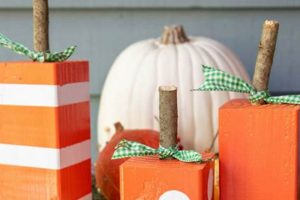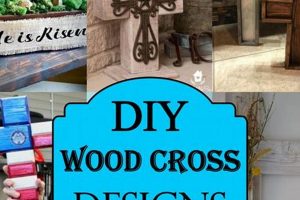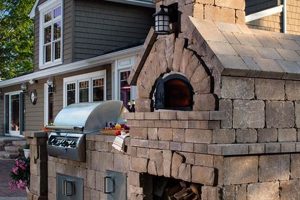The construction of receptacles for plant cultivation, crafted from lumber by non-professional individuals, represents a segment of horticultural practices. These self-made containers serve as alternatives to commercially manufactured products and offer a customizable approach to gardening. As an example, a simple box constructed from reclaimed pallet wood to house herbs on a balcony exemplifies this approach.
The appeal of this horticultural pursuit lies in its cost-effectiveness, personalization options, and sustainability potential. It provides an avenue for utilizing recycled materials, tailoring size and design to specific spatial needs, and fostering a sense of accomplishment. Historically, homemade plant containers have existed in various forms, reflecting available materials and evolving construction techniques, often representing resourcefulness and a connection to the natural world.
The subsequent sections will address key considerations in constructing such a horticultural feature, including material selection, design principles, construction techniques, and finishing options. Each element contributes to the longevity, functionality, and aesthetic appeal of the final product, ultimately enhancing the gardening experience.
Tips for Crafting a Durable Horticultural Container
The following guidelines aim to ensure the successful construction of durable and aesthetically pleasing plant containers. Adherence to these recommendations will enhance longevity and functionality.
Tip 1: Select Durable Lumber: Employ naturally rot-resistant wood species, such as cedar, redwood, or cypress. These woods contain oils that inhibit decay, extending the lifespan of the structure. Pressure-treated lumber offers an alternative, but necessitates careful consideration regarding potential chemical leaching into the soil.
Tip 2: Prioritize Proper Drainage: Adequate drainage is paramount to prevent root rot. Drill drainage holes into the base of the container, ensuring they are of sufficient size and number to allow water to escape freely. Consider adding a layer of gravel or coarse sand at the bottom to further enhance drainage.
Tip 3: Employ Corrosion-Resistant Fasteners: Utilize galvanized or stainless steel screws and nails. Standard fasteners will corrode over time, compromising the structural integrity of the container. Selecting appropriate hardware is a crucial investment in longevity.
Tip 4: Reinforce Corners and Seams: Strengthening corners and seams prevents warping and separation, especially when the container is filled with soil. Employ corner braces, wood glue, or interlocking joinery techniques to enhance stability.
Tip 5: Consider Liner Options: A liner can protect the wood from constant moisture exposure. Options include heavy-duty plastic sheeting, landscape fabric, or specialized container liners. Ensure the liner is properly installed to prevent water from becoming trapped between the liner and the wood.
Tip 6: Apply a Protective Finish: Sealing the exterior of the container with a water-resistant finish, such as paint or sealant, provides an additional layer of protection against the elements. Choose a finish appropriate for exterior use and reapply as needed to maintain its protective qualities.
Tip 7: Design for Adequate Size: Account for the mature size of the plants to be housed within the container. Under-sizing the container will restrict root growth and potentially lead to plant stress. Research plant-specific requirements to determine appropriate dimensions.
Adhering to these tips will result in a long-lasting and functional structure, promoting healthy plant growth and enhancing outdoor spaces. Careful material selection, construction techniques, and finishing touches contribute to the overall success of the project.
The following sections will address advanced design considerations and aesthetic enhancements for customized plant containers.
1. Durability
The lifespan of a self-constructed plant receptacle is directly contingent upon its inherent robustness, or durability. This quality stems from a confluence of factors, including material selection, construction methodology, and environmental exposure. The selection of inherently decay-resistant wood species, such as cedar or redwood, constitutes a primary determinant of longevity. Conversely, the utilization of untreated, less resistant lumber will inevitably result in premature degradation, necessitating frequent replacement or repair. For instance, a container built from untreated pine and exposed to consistent moisture may exhibit signs of rot within a single growing season, while a cedar alternative could endure for several years under similar conditions.
Beyond material, construction techniques significantly impact long-term performance. Secure joinery, utilizing corrosion-resistant fasteners, prevents structural weakening over time. The absence of proper reinforcement at corners and seams renders the structure vulnerable to stress fractures and eventual collapse, particularly when burdened with the weight of soil and plants. Moreover, external factors such as ultraviolet radiation and fluctuating temperatures exert considerable influence. The application of protective coatings or sealants mitigates these effects, prolonging the container’s service life. Therefore, careful consideration must be given to lumber treatments and water-resistent paints.
In summary, durability constitutes a critical aspect of the design and fabrication of self-constructed plant receptacles. Its absence translates to increased maintenance requirements, compromised aesthetic appeal, and ultimately, a shortened functional lifespan. By prioritizing robust materials, employing sound construction principles, and implementing appropriate protective measures, it becomes possible to create containers that withstand environmental stresses and provide lasting value for horticultural endeavors.
2. Drainage
Effective drainage is a critical factor in the functionality and longevity of a self-constructed plant receptacle. The absence of adequate water removal from the soil matrix directly contributes to a range of deleterious effects on plant health. Root rot, a prevalent issue in poorly drained containers, arises from prolonged exposure of roots to anaerobic conditions, fostering the proliferation of pathogenic fungi. This condition inhibits nutrient uptake, impairs root function, and ultimately leads to plant decline or death. As a practical example, a vegetable box constructed without drainage holes and subjected to heavy rainfall will quickly become waterlogged, creating an environment conducive to root rot and hindering the growth of the plants within.
The implementation of proper drainage solutions in a timber-based plant container involves several key considerations. Firstly, the provision of appropriately sized and positioned drainage apertures in the container base is essential. The number and diameter of these openings should be proportionate to the container’s volume and the water retention characteristics of the potting mix employed. Furthermore, the incorporation of a drainage layer, composed of gravel, coarse sand, or broken pottery shards, at the bottom of the container facilitates water flow away from the root zone. This layer acts as a reservoir, preventing the soil from becoming saturated and promoting aeration. As a contrasting illustration, a flower box using a fast-draining potting mix and ample drainage holes will require more frequent watering, but will minimize the risk of root-related diseases.
In summary, the integration of effective drainage mechanisms is indispensable for maintaining a healthy soil environment within a self-constructed plant receptacle. Failing to address this fundamental aspect compromises plant vitality and shortens the lifespan of the container. The adoption of proactive drainage strategies, including appropriately sized drainage holes and the utilization of drainage layers, mitigates the risks associated with waterlogged soil and promotes sustained plant growth. This understanding is pivotal in achieving successful horticultural outcomes in container gardening applications.
3. Aesthetics
The visual appeal of a self-constructed timber receptacle, or the aesthetics, represents a significant element in its overall value. Beyond purely functional considerations, the visual integration of such structures into the surrounding environment impacts the perceived quality and enjoyment of outdoor spaces.
- Wood Grain and Texture
The inherent grain patterns and surface texture of lumber exert a substantial influence on the visual character of the finished receptacle. The selection of wood species with distinctive grain, such as figured maple or knotty pine, introduces visual interest. The milling process, whether rough-sawn or smoothly planed, further modifies the surface appearance. Employing reclaimed timber, with its inherent imperfections and weathered patina, imparts a rustic aesthetic. Contrasting these textural elements against the smooth foliage of the plants creates visual depth.
- Design and Form
The overall design and form of the plant container contribute significantly to its aesthetic impact. Simple geometric shapes, such as squares and rectangles, offer a clean and modern appearance. More elaborate designs, incorporating curves, angles, or decorative elements, can evoke a more traditional or artistic sensibility. The size and proportions of the container relative to the plants it houses, and the surrounding landscape, influence the visual harmony of the composition. For example, an oversized container with dwarfed plants can appear unbalanced.
- Color and Finish
The color palette and surface finish applied to the timber profoundly affect its visual presentation. Natural wood tones, enhanced by clear sealants, offer a warm and organic aesthetic. Painted finishes allow for the incorporation of specific colors to complement the surrounding environment or to create visual contrast. The choice of finish, whether matte, satin, or gloss, influences the reflectivity and overall appearance of the surface. Weathered or distressed finishes can impart a sense of age and character.
- Integration with Surroundings
The successful integration of the timber container with its surroundings is crucial for achieving a cohesive aesthetic. The container’s style, color, and size should harmonize with the architectural style of the adjacent building, the existing landscape design, and the overall color scheme of the outdoor space. The placement of the container, considering factors such as sunlight exposure and visual sightlines, influences its visibility and impact. Grouping multiple containers together in a cohesive arrangement can create a more impactful visual statement.
In conclusion, aesthetic considerations are integral to the design and construction of self-constructed lumber receptacles. The selection of materials, design of form, application of color and finish, and integration with surroundings combine to shape the final visual outcome. A well-considered aesthetic elevates the container beyond mere functionality, transforming it into a visually pleasing element that enhances the overall ambiance of the outdoor space.
4. Sustainability
The integration of sustainability principles into the construction of plant containers represents a tangible application of environmentally conscious practices. This approach necessitates a mindful consideration of resource utilization, waste minimization, and the long-term ecological impact of the structure’s lifecycle.
- Reclaimed Lumber Utilization
Employing reclaimed lumber, sourced from deconstructed buildings, discarded pallets, or other salvaged sources, significantly reduces the demand for newly harvested timber. This practice minimizes deforestation, preserves forest ecosystems, and reduces the energy expenditure associated with lumber production. For example, utilizing pallet wood to construct a raised garden bed repurposes a waste product, diverting it from landfills and imbuing it with a new functional purpose.
- Locally Sourced Materials
Prioritizing the procurement of lumber from local suppliers minimizes transportation distances, thereby reducing the carbon footprint associated with shipping and distribution. Supporting local sawmills and lumberyards fosters regional economic resilience and reduces reliance on global supply chains. For instance, selecting timber harvested from a nearby sustainable forest contributes to the local economy and reduces the environmental impact of long-distance transport.
- Non-Toxic Treatments and Finishes
Opting for non-toxic wood preservatives, sealants, and finishes mitigates the release of harmful chemicals into the environment and protects the health of both plants and humans. Traditional wood treatments often contain volatile organic compounds (VOCs) that contribute to air pollution and can leach into the soil. Utilizing natural oils, waxes, or water-based finishes provides a safer and more environmentally responsible alternative.
- Longevity and Durability
Constructing plant containers designed for long-term durability minimizes the need for frequent replacement, thereby reducing the consumption of resources and the generation of waste. Employing durable materials, robust construction techniques, and protective finishes extends the lifespan of the container, ensuring its continued functionality and aesthetic appeal for an extended period.
The integration of these sustainable practices into the construction of these garden elements fosters a holistic approach to gardening, aligning horticultural endeavors with broader environmental goals. By prioritizing resource conservation, waste reduction, and the utilization of eco-friendly materials, such projects contribute to a more sustainable and resilient future.
5. Customization
The intrinsic link between self-constructed plant receptacles and customization represents a primary driver for their adoption in diverse horticultural settings. The capacity to tailor dimensions, materials, and design elements to specific requirements distinguishes these projects from mass-produced alternatives. A direct consequence of this adaptability is the enhanced integration of the container within the intended environment, both functionally and aesthetically. For instance, a constrained urban balcony may necessitate a narrow, vertically oriented planter, crafted from lightweight lumber to minimize structural load; a readily achievable modification within the scope of self-construction, but potentially unavailable as a standard commercial offering.
Furthermore, customization extends beyond mere dimensional adjustments, encompassing material choices and construction techniques aligned with specific plant needs or aesthetic preferences. The selection of untreated cedar, known for its natural resistance to decay, directly impacts the health and vitality of plants cultivated within, by avoiding potential chemical leaching associated with treated lumber. Similarly, the incorporation of a self-watering reservoir, integrated into the container’s design, caters to the specific moisture requirements of particular plant species, simplifying maintenance and optimizing growth. The practical significance of this personalized approach lies in the optimization of growing conditions, leading to improved plant health, yield, and overall horticultural success. As an illustrative example, constructing a planter with integrated trellis supports allows for the cultivation of climbing vegetables in a compact space, a feature frequently absent in commercially available planters.
In conclusion, the ability to customize represents a cornerstone advantage of self-constructed plant receptacles. This adaptability enhances their suitability for a wide range of environments and horticultural applications, fostering a more integrated and sustainable approach to gardening. While challenges may arise in mastering specific construction techniques or sourcing specialized materials, the potential benefits of personalized plant containers, in terms of functionality, aesthetics, and environmental responsibility, underscore their enduring appeal to gardeners of all skill levels.
Frequently Asked Questions
The following questions address common concerns and misconceptions regarding the construction and utilization of timber-based plant containers.
Question 1: Which timber species offer the greatest resistance to decay for use in outdoor plant receptacles?
Naturally durable wood species such as cedar, redwood, cypress, and white oak exhibit inherent resistance to rot and insect infestation, making them suitable for exterior applications. Pressure-treated lumber also offers decay resistance, but requires careful consideration due to potential chemical leaching into the soil. Selecting a durable timber species is crucial for extending the lifespan of the construction.
Question 2: What constitutes adequate drainage in a timber-based container, and what are the consequences of insufficient drainage?
Adequate drainage requires sufficient drainage holes, typically to inch in diameter, spaced evenly across the container base. The incorporation of a drainage layer, consisting of gravel or coarse sand, further enhances water removal. Insufficient drainage leads to waterlogged soil, promoting root rot and hindering plant growth.
Question 3: How can the structural integrity of a timber-based container be enhanced to withstand the weight of soil and plants?
Structural integrity can be enhanced through the use of robust joinery techniques, such as mortise and tenon joints or reinforced butt joints. Employing corrosion-resistant fasteners, such as galvanized or stainless steel screws, is essential. Reinforcing corners with metal brackets or additional lumber further strengthens the construction.
Question 4: What are the potential risks associated with using pressure-treated lumber in a plant receptacle, and how can these risks be mitigated?
Pressure-treated lumber may contain chemicals that can leach into the soil and potentially affect plant health. Lining the container with a heavy-duty plastic liner or landscape fabric can mitigate this risk. Selecting pressure-treated lumber certified for ground contact applications is also advisable.
Question 5: Is it necessary to apply a finish to a timber-based plant receptacle, and what types of finishes are recommended?
Applying a finish enhances the aesthetic appeal and protects the lumber from the elements, extending its lifespan. Water-resistant paints, stains, or sealants formulated for exterior use are recommended. Natural oils, such as linseed oil, offer a less toxic alternative, although they may require more frequent reapplication.
Question 6: What are the key considerations when selecting a potting mix for use in a timber-based container?
The potting mix should be well-draining, lightweight, and nutrient-rich. A blend of peat moss, perlite, and vermiculite provides optimal drainage and aeration. Adding compost or other organic matter enhances nutrient content. Avoid using garden soil, as it tends to compact and impede drainage.
Proper planning, material selection, and construction techniques are crucial for creating a durable and functional plant structure.
The subsequent section will explore advanced design considerations and creative embellishments for customizing timber structures.
Conclusion
The preceding exploration of the design, construction, and utilization of diy wooden planter structures underscores their multifaceted nature. Key considerations, including material selection, structural integrity, drainage efficiency, and aesthetic integration, directly impact the success of these horticultural projects. Sustainable practices, such as the utilization of reclaimed lumber and non-toxic finishes, offer environmentally responsible approaches to container gardening. The capacity for customization further distinguishes these self-constructed elements, enabling tailored solutions for diverse plant needs and spatial constraints.
The enduring relevance of the diy wooden planter concept lies in its capacity to empower individuals to cultivate plants in a personalized and sustainable manner. Continued innovation in materials, design techniques, and construction methods will undoubtedly further enhance the functionality and longevity of these structures. The pursuit of knowledge and refinement of skills in this area remains a worthwhile endeavor for both novice and experienced gardeners alike, fostering a deeper connection with the natural world and promoting self-sufficiency in horticultural practices.







